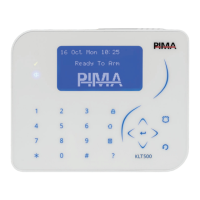7: CMS & Communications
PIMA Electronic Systems
25
7 CMS & Communications
The
CMS & Communications
menu includes the following sub-menus:
1) Monitoring Stations; see below.
2) PIMA Cloud; see section 7.2, on page 28.
3) General Settings; see section 7.1.3, on page 28.
4) Telephone Settings; see section 7.4, on page 29.
5) Network Settings; see section 7.5, on page 29.
6) Cellular Settings; see section 7.6, on page 30.
7.1 Monitoring Stations
System Configuration
CMS & Communications
Monitoring Stations
The
Monitoring Stations
menu includes the following sub-menus:
1) CMS
1-2; see below.
2) Radio; see section 7.1.2, on page 27.
3) Custom Zones Reports; see section 7.1.3, on page 28.
7.1.1 CMS 1-2
System Configuration
CMS & Communications
Monitoring Stations
CMS 1-
2
The
CMS 1-2
menu includes the following sub-menus:
1) Comm. Paths; see below.
2) Event Reporting: see page 26.
3) CMS Name: user text, up to 16 characters.
4) CMS Lock Code: set a lock code to the definitions of this CMS.
Comm. Paths
System Configuration
CMS & Communications
Monitoring Stations
CMS 1-2
Comm. Paths
The
Communication Paths
menu includes the following sub-menus:
1) Telephone (PSTN). The parameters in this menu are:
For each defined partition, set an ID number. If you
only set partition 1’s number, it will serve all other
partitions.
Set up to 4 numbers of the CMS.
Up to 16
digits per
number
Select the CMS PSTN protocol from the list. The options
are: ContactID, SIA
11
, and NPAF.
A parameter required by the NPAF protocol only.
Consult the CMS.
Central Monitoring Station
Consult with PIMA support team regarding the functionality of the PID and SIA protocols

